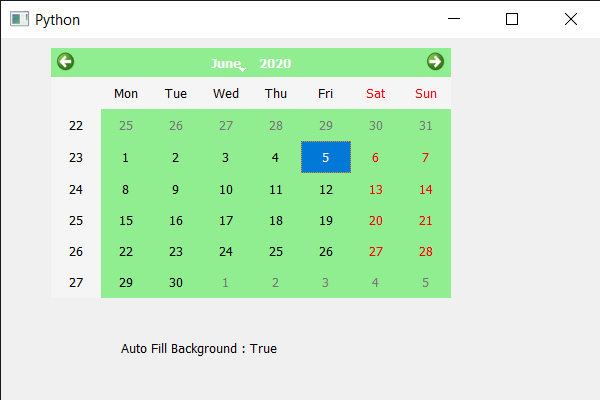En este artículo veremos cómo obtenemos la propiedad de autocompletar del QCalendarWidget, esta propiedad hará que Qt llene el fondo del calendario antes de invocar el evento de pintura. El color utilizado está definido por la QPalette. De forma predeterminada, esta propiedad es falsa y se puede cambiar con la ayuda del método setAutoFillBackground.
Para hacer esto, usaremos el método autoFillBackground con el objeto QCalendarWidget.
Sintaxis : calendar.autoFillBackground(True)
Argumento : No requiere argumento
Devolución : Devuelve bool
A continuación se muestra la implementación.
Python3
# importing libraries
from PyQt5.QtWidgets import *
from PyQt5 import QtCore, QtGui
from PyQt5.QtGui import *
from PyQt5.QtCore import *
import sys
class Window(QMainWindow):
def __init__(self):
super().__init__()
# setting title
self.setWindowTitle("Python ")
# setting geometry
self.setGeometry(100, 100, 600, 400)
# calling method
self.UiComponents()
# showing all the widgets
self.show()
# method for components
def UiComponents(self):
# creating a QCalendarWidget object
self.calendar = QCalendarWidget(self)
# setting geometry to the calendar
self.calendar.setGeometry(50, 10, 400, 250)
# setting style sheet
self.calendar.setStyleSheet("background : lightgreen;")
# enabling auto fill background
self.calendar.setAutoFillBackground(True)
# creating a label
label = QLabel(self)
# setting geometry
label.setGeometry(120, 280, 200, 60)
# making it multi line
label.setWordWrap(True)
# getting the auto fill background property
value = self.calendar.autoFillBackground()
# setting text to the label
label.setText("Auto Fill Background : " + str(value))
# create pyqt5 app
App = QApplication(sys.argv)
# create the instance of our Window
window = Window()
# start the app
sys.exit(App.exec())
Producción :

Publicación traducida automáticamente
Artículo escrito por rakshitarora y traducido por Barcelona Geeks. The original can be accessed here. Licence: CCBY-SA